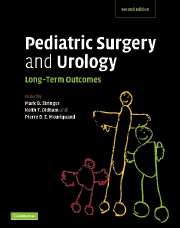18 results
Contents
-
- Book:
- Pediatric Surgery and Urology
- Published online:
- 08 January 2010
- Print publication:
- 09 November 2006, pp vii-x
-
- Chapter
- Export citation
Index
-
- Book:
- Pediatric Surgery and Urology
- Published online:
- 08 January 2010
- Print publication:
- 09 November 2006, pp 1015-1071
-
- Chapter
- Export citation

Pediatric Surgery and Urology
- Long-Term Outcomes
-
- Published online:
- 08 January 2010
- Print publication:
- 09 November 2006
Plate section
-
- Book:
- Pediatric Surgery and Urology
- Published online:
- 08 January 2010
- Print publication:
- 09 November 2006, pp -
-
- Chapter
- Export citation
Frontmatter
-
- Book:
- Pediatric Surgery and Urology
- Published online:
- 08 January 2010
- Print publication:
- 09 November 2006, pp i-vi
-
- Chapter
- Export citation
Part VII - Transplantation
-
-
- Book:
- Pediatric Surgery and Urology
- Published online:
- 08 January 2010
- Print publication:
- 09 November 2006, pp 843-844
-
- Chapter
- Export citation
Part IV - Abdomen
-
-
- Book:
- Pediatric Surgery and Urology
- Published online:
- 08 January 2010
- Print publication:
- 09 November 2006, pp 253-254
-
- Chapter
- Export citation
Part VIII - Trauma
-
-
- Book:
- Pediatric Surgery and Urology
- Published online:
- 08 January 2010
- Print publication:
- 09 November 2006, pp 913-914
-
- Chapter
- Export citation
Part III - Thorax
-
-
- Book:
- Pediatric Surgery and Urology
- Published online:
- 08 January 2010
- Print publication:
- 09 November 2006, pp 133-134
-
- Chapter
- Export citation
List of contributors
-
- Book:
- Pediatric Surgery and Urology
- Published online:
- 08 January 2010
- Print publication:
- 09 November 2006, pp xi-xx
-
- Chapter
- Export citation
Acknowledgments
-
-
- Book:
- Pediatric Surgery and Urology
- Published online:
- 08 January 2010
- Print publication:
- 09 November 2006, pp xxi-xxii
-
- Chapter
- Export citation
Part VI - Oncology
-
-
- Book:
- Pediatric Surgery and Urology
- Published online:
- 08 January 2010
- Print publication:
- 09 November 2006, pp 725-726
-
- Chapter
- Export citation
3 - Outcomes analysis and systems of children's surgical care
- from Part I - General issues
-
-
- Book:
- Pediatric Surgery and Urology
- Published online:
- 08 January 2010
- Print publication:
- 09 November 2006, pp 29-38
-
- Chapter
- Export citation
Preface
-
-
- Book:
- Pediatric Surgery and Urology
- Published online:
- 08 January 2010
- Print publication:
- 09 November 2006, pp xxiii-xxiv
-
- Chapter
- Export citation
Part V - Urology
-
-
- Book:
- Pediatric Surgery and Urology
- Published online:
- 08 January 2010
- Print publication:
- 09 November 2006, pp 529-530
-
- Chapter
- Export citation
Part IX - Miscellaneous
-
-
- Book:
- Pediatric Surgery and Urology
- Published online:
- 08 January 2010
- Print publication:
- 09 November 2006, pp 945-946
-
- Chapter
- Export citation
Part I - General issues
-
-
- Book:
- Pediatric Surgery and Urology
- Published online:
- 08 January 2010
- Print publication:
- 09 November 2006, pp 1-2
-
- Chapter
- Export citation
Part II - Head and neck
-
-
- Book:
- Pediatric Surgery and Urology
- Published online:
- 08 January 2010
- Print publication:
- 09 November 2006, pp 65-66
-
- Chapter
- Export citation



